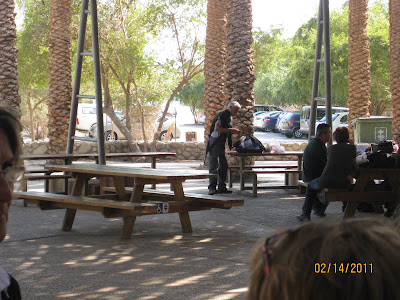
The most interesting part of Masada isn't that it was a Palace for King Herod, however. After the time of Herod the city of Masada was inhabited by Jews who fled from Jerusalem when the Romans were taking over the city. It was the site of the "Jewish Revolt" - the last group of Jews who stood in defiance to the Roman empire. The Romans came to kill them but couldn't reach the top! Keep reading as the story unfolds...

From the cable car you can see stone ruins besides Masada in the distance...part of them in a line, and part of them in a square. The line is the ruins from where the Romans built a wall around the entire city when they were laying siege to Masada. The square is one of their camps; they were fortified around the city for months.
Now for the rest of the story! The Romans continued to siege the city, but the siege backfired and ended up worse for them than it was for the Jews. Since King Herod had massive stores of water in cisterns from over 70 years ago, the Jews had more than enough food and water up on the mountain. It is said they splashed around and even dumped some down the mountain every once in awhile to taunt the Romans. Meanwhile the Romans were dying of thirst and starvation, so they had to end this siege. Over the course of 6 months, they finally built a giant man-made mountain/ramp that would allow them access to break down the main gate. In the picture above, you can see part of the ramp they built; this is the lowest part of Masada. Trapped with seemingly no other options, the Jews decided it was best to be dead rather than face torture, rape, and slavery. Just before the Romans broke down their gate, the Jews decided they should die by way of their own swords. This was not via suicide, because they thought that was a terrible sin, but rather each man killed his own family and then the men killed each other - only the last man killed himself. So, when the Romans broke through the next day, the entire city was a ghost town.
Thus ends the story of Masada...the "Jewish Alamo" (or better yet, the Alamo should be described as the "American Masada").
On the way back down Masada, some of us decided to descend on foot rather than use the cable cars. Here's a shot of my cousin Andy and I about half way down. It was quite a workout, even going down!
En Gedi
In the middle of the Israeli desert, the springs of En Gedi are a true oasis. Surrounding the area is lush green plant life and flowing fresh water. Above is one of three waterfalls that make up this oasis. This one is at the top and is called David's waterfall; it isn't a mighty falls but is sure tall!
We both made the hike to the top to see this beautiful falls.
These caves bring the Biblical history of En Gedi to life. In 1 Samuel 24, as Saul is pursuing David to try and kill him, David and his men are hiding deep in En Gedi caves just like these. Saul goes into a cave to relieve himself and David cuts off a piece of his robe.
Hiking back down the trail, here is a beautiful view with the Dead Sea in the background.
En Gedi literally means "spring of the wild goat", and the wild goats in this area are called ibex. A herd of ibex decided to cross right in front of the path and pose for the camera. Can you see both of them?
We found out that any group of youth traveling in Israel must travel with an armed escort - it's a law. Seeing a random guy walking next to us with a rifle was a bit disconcerting.
We've really been slacking in taking food shots...we'll try to correct that. Here is a shot of one lunch...something like beef-a-roni with a pita on the side.
...and the other lunch plate has a mixture of salad items with a pita on the side. Guess whose is whose?!
Judean Wilderness
 We stopped at the Judean Wilderness, which is believed to be the very spot Satan tempted Jesus Christ for 40 days. My grandfather taught us from Matthew chapter 3.
We stopped at the Judean Wilderness, which is believed to be the very spot Satan tempted Jesus Christ for 40 days. My grandfather taught us from Matthew chapter 3. In Pennsylvania "out in the middle of nowhere" means you might be in a forest, near a creek, or in a corn field. In Israel it means you're in the desert. The view is beautufil out here in the middle of nowhere!
In Pennsylvania "out in the middle of nowhere" means you might be in a forest, near a creek, or in a corn field. In Israel it means you're in the desert. The view is beautufil out here in the middle of nowhere!Jerusalem / Mt. Of Olives

Here's a view from the top of the Mount of Olives down into Jerusalem.
Back at the hotel, a dinner buffet awaits us. This is the style of all our dinners and breakfasts at the hotels - buffets! There are always lots of yummy choices, and we won't be getting any thinner any time soon.
The buffets at each hotel always include a "salad bar", which is a wide variety of cut greens, cheeses, hummus, olive dishes, and pitas. This hotel does it right...complete with an olive tree as a centerpiece.















No comments:
Post a Comment